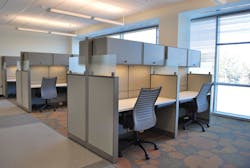About 2.4 million new students will enter colleges and universities over the next decade, according to the National Center for Education Statistics. To accommodate this growth in enrollment, some schools are hiring contractors for renovation and new construction projects. Right now, however, this increased activity is happening more on the private, rather than public, side of higher education, says Kim Kennedy, manager of forecasting for McGraw-Hill Construction’s Dodge Analytics in Bedford, Mass.
“The recession of 2008 and 2009 hit the construction market particularly hard, and higher education was no exception,” says Kennedy. “Public colleges and universities were affected by the poor fiscal condition of the states, and they are still working their way through this process. We’re not particularly hopeful about growth in this area — at least through the end of this year.”
Bob Murray, VP of economics for McGraw-Hill Construction, agrees, saying the general picture for the higher education market is one of further decline. Back in 2001, total education construction starts soared to 273 million sq ft, but two years ago, that number sank to 132 million sq ft, according to McGraw-Hill Construction. The
college and university piece of the market declined further during 2012, with starts falling 11%. Square footage for new buildings and additions to existing buildings also dropped 21% for colleges and universities (see Table).
While the higher education market experienced a drop in starts and square footage, about 14 projects costing $100 million or more broke ground in 2012, including the University of Chicago’s $166-million William Eckhardt Research Center. Some of the private colleges and universities are also starting to invest more money in new buildings and renovation projects, says Kennedy.
“Financing was very tight after the financial crisis of 2008, but the market is very slowly improving,” she says. “When the stock market does well, alums and other donors feel wealthier, making them more apt to give. The schools’ larger endowments then allow them to spend money on additional buildings.”
The state of the economy may drive the higher education market in the short-term, but in the long-run, demographics will play a central role, she says.
“Colleges and universities are still showing strong increases in enrollments, and it’s not just traditional college students,” continues Kennedy. “More and more non-traditional students are returning to college for higher education.”
In Georgia, Putzel Electrical Contractors is seeing some strength return to the higher education market, says John Champagne, president. Because the enrollment at college campuses is growing, the contractor is seeing more demand for classroom space. Recently, his firm has seen a lot of smaller renovation projects come its way, but a few larger opportunities will soon be coming to market.
“The universities have been more selective about what they fund, and it’s taken much longer to get jobs approved,” he says. “There are some bigger jobs coming up in the pipeline, however. Overall, it’s trending positively.”
For example, colleges and universities are investing in renovation projects for high-level laboratories to attract funding, potential students, and faculty. At Georgia Institute of Technology, Putzel Electrical Contractors recently completed a more than 13,000-sq-ft build-out for an existing building, including the construction of seven new high-density lab areas that feature steel lab casework, modular storefronts, acid-resistant flooring, and new lab equipment. The company also wired a dozen new office areas to support the lab space.
As a result of its increased workload in the higher education market, Champagne is seeing an upturn in this sector.
“We as a company are winning more work and getting more opportunities,” he says.
Fischbach is a freelance writer and editor in Overland Park, Kan. She can be reached at [email protected].




